
Space Environment
ROOM
86
an eclipsing binary system, was first noticed as
far back as 1667. Successive observations have
revealed that Algol A, while more massive than
its companion Algol B, is less evolved. This would
occur if Algol A transferred much of its mass to
Algol B as they evolved; a process that would be
impossible if the stars formed on their own.
The likelihood of a star having a companion
depends on its mass. Stars like our Sun have a 40
percent chance of being in a binary while among
lower-mass red dwarfs, with masses one tenth
of our Sun, the chance is below 20 percent. At
the other end of the scale, the most massive and
brightest stars with masses in excess of ten times
the Sun, at least 70 percent have a companion
star. Recent work shows that of these, many are
so close that the stars interact by mass exchange
during their lifetimes, significantly altering their
stellar evolution. This can occur when mixing,
induced by the proximity of the secondary
star, transforms one of them into a chemically
peculiar star. Not only that, if the stars are close
enough, the binary system can merge to form
a new single star. This has been proposed as an
evolutionary route to making double black hole
binaries, which can later merge into one with
the emission of detectable gravitational waves.
Indeed, if we look only at very massive, single
stars in the sky, half of them used to be binaries
and have now merged. Understanding binaries
is thus critical to understanding stars and the
physics that drives them.
Extreme physics
Mass transfer in a binary system is the key process
in changing a star’s evolutionary sequence and it
is linked to an imaginary surface that lies between
the two stars. Known as the Roche surface, it is
shaped as a figure of eight with a star in each lobe
and is the critical location at
which gas is equally bound to both stars. If the
star’s surface crosses the Roche surface, mass is
exchanged and can alter the evolution of both
stars forever.
Processes that can cause a star to cross the
Roche surface include a shortening of the orbital
separation of the binary, or the expansion of one
of the stars. When two bodies are sufficiently
close to one another, their mutual gravitational
pull induces a tide. Just like the gravity of the
Moon makes tidal bulges in Earth’s oceans, two
orbiting stars cause tidal bulges on each other.
These bulges result in the transfer of angular
momentum (a measure of rotation) from the
Binary star system
SR24 in the constellation
of Ophiuchus as observed
with the Subaru
Telescope.
Understanding
binaries is
critical to
understanding
stars and the
physics that
drives them


